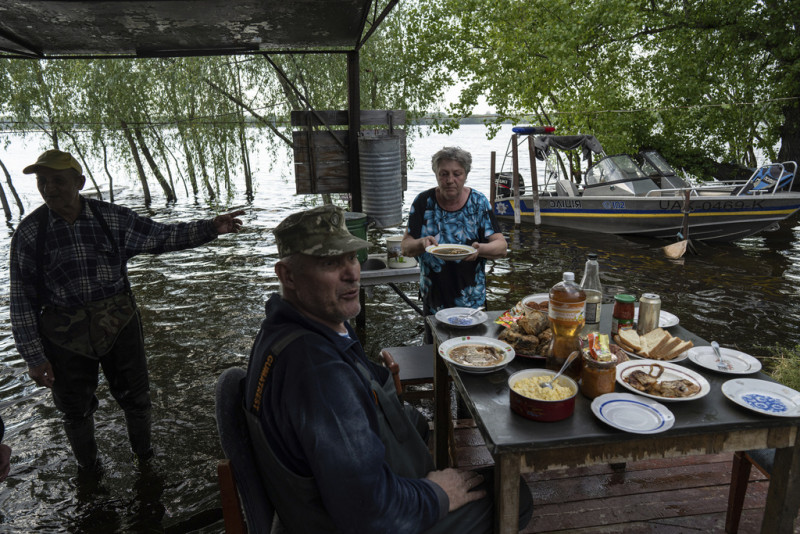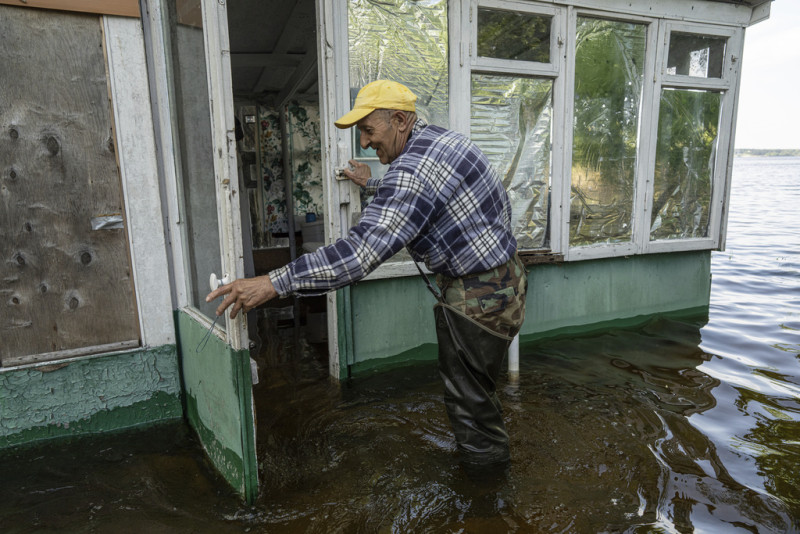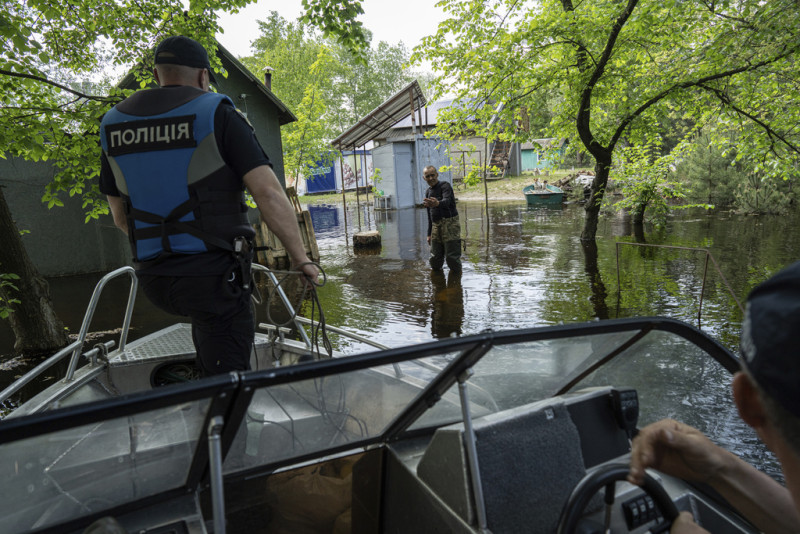The Kremlin insists that the partial destruction of a hydroelectric dam in Kherson is a deliberate act of sabotage by Kiev – For its part, the Ukrainian military accused Russia in a statement of organizing an explosion at the dam
The Kremlin condemned today a deliberate act of sabotage of Kiev after the partly hydroelectric dam destruction in Khersona region partially held by Russian forces in southern Ukraine.
“This is undoubtedly a deliberate act of sabotage by the Ukrainian side, which was planned and carried out at the behest of Kiev,” Kremlin spokesman Dmitry Peskov told reporters, noting that he “categorically” rejected the Ukrainian authorities’ accusations that blame Moscow for the rupture of the Kahovka dam.
“All the responsibility lies with the Kiev regime,” Peskov insisted, adding that one of the goals of this action was to “deprive water from Crimea,” the peninsula annexed by Russia in 2014.
The hydroelectric dam at Nova Kahovka, built on the Dnieper River in the 1950s and occupied since the start of the Russian invasion of Ukraine in February 2022, is critical for supplying water to the annexed Crimean peninsula.
According to Peskov, “this act of sabotage could possibly have very serious consequences for tens of thousands of residents of the region” of Kherson, as well as “ecological consequences”.
On his part, Mr Ukrainian army accused in his announcement the Russia that organized a explosion in the barrier. Ukrainian President Volodymyr Zelensky has urgently convened the Ukrainian Security Council, the head of the Ukrainian presidential administration, Andriy Yermak, announced via Telegram, denouncing a “war crime”.
Water levels have risen in communities near the dam, but the situation is not critical, according to the Russian-appointed administration of the Kherson region.
The water level around the dam has risen by five meters and many islands in the river have disappeared under waterthe state news agency RIA reported, according to which 14 settlements in Kherson are at risk of flooding and 22,000 people living in them are threatened.
“If necessary, we are ready to evacuate the residents of the coastal villages,” the head of the government of the Kherson region, Andrei Aleksejenko, said in a Telegram message, stressing, however, that their lives are not threatened and calling on them “not to panic.” .
The Kakhovka dam, which has been occupied since the beginning of the Russian offensive in Ukraine, allows water to be supplied to the Crimean peninsula, annexed in 2014 by Moscow.
The dam was created on the Dnieper River in 1956, during the Soviet period, and is made partly of concrete and earth.
It is one of the largest infrastructures of this type in Ukraine.
Kiev blames Russian forces
The Ukrainian presidency this morning accused Russia of “blowing up” the Kahovka hydroelectric dam in the southern Ukrainian region of Khresona overnight to flood the area and put the brakes on a Ukrainian offensive in preparation.
“The goal of the terrorists is obvious: to prevent the aggressive actions of the Ukrainian armed forces,” Mykhailo Podoliak, an adviser to the Ukrainian presidency, said in a message to reporters.
The Ukrainian military intelligence service claimed for its part that the Russian forces blew up the dam in “panic”. “The occupying forces blew up the dam at the Kahovka Reservoir in a panic – this is an obvious act of terrorism and a war crime, which will be prosecuted in an international court.”
The hydroelectric plant was “completely destroyed”
Will be possibly impossible to repair the hydroelectric dam of Kakhovka after the explosion caused a breach in the structure, a Russian-appointed official in the Russian-held town of Nova Kakhovka said today.
In comments on Russian state television, the city’s mayor, Vladimir Leontiev, noted that the damage to the dam was the result of a series of Ukrainian strikes.
Reuters has not yet been able to independently confirm this information.
Leontiev also noted, according to Russian news agency TASS, that residents of about 300 houses were evacuated after the damage caused to the dam and added that part of the city was disconnected from the electricity supply network for security reasons.
According to Ukraine’s state-owned hydroelectric company, the Khakhovka Hydroelectric Power Plant in the Russian-held region of southern Ukraine was “completely destroyed” and cannot be restored after an explosion that it said inside his engine room.
Ukrainian Prime Minister Denis Smykhal said separately that up to 80 communities are at risk of flooding after, as he described it, the destruction of the dam of the station by the Russian forces.
Several villages have been “fully or partially” flooded in Ukraine after the Kakhovka hydroelectric dam on the Dnieper in the Russian-held Kherson region was partially destroyed, and the evacuation of residents has begun, another Ukrainian official said.
“About 16,000 people are in a critical zone,” Oleksandr Prokudin, head of the military administration of the Kherson region, said in a social media post.
At the same time, TASS reported, citing emergency services, that the water reserves in the Crimean water reservoirs are sufficient after the rupture of the dam in Nova Kahovka.
The Crimean peninsula, annexed by Russia, depends for drinking water on the North Crimean Canal, which brings water to the peninsula from the Dnieper River.
Ukraine has previously cut off water supplies to Crimea after Russia annexed the peninsula in 2014, causing acute water shortages in the region.
No major settlements are threatened by flooding, according to the Russian occupation forces
Meanwhile, Moscow-appointed authorities in Kherson stressed that no major settlements were threatened by flooding after the partial destruction of the Kahovka hydroelectric dam on the Dnieper River.
“According to the rescue services, the water level has risen (…) to a level estimated between 2 and 4 meters, which does not threaten large settlements”, which are at a lower level than the dam along of the river, Andriy Aleksejenko, the Moscow-appointed head of authorities in Kherson, a region partially held by Russian forces in southern Ukraine, noted in a Telegram post.
In total, the “coastal villages” of 14 settlements, where “more than 22,000 people” live, are threatened by flooding, he explained.
“If necessary we are ready to evacuate the residents”, assured Aleksejenko, noting however that their lives are not threatened and that “the situation is completely under control”.
For his part, the mayor of Nova Kahovka, appointed by the Russian forces, Vladimir Leontiev, announced a short time later the evacuation of the residents of “about 300 houses” located right on the banks of the Dnieper.
🇷🇺 Swans swim near the Palace of Culture in Nova Kakhovka pic.twitter.com/lNyKGIMrCZ
— Sinnaig (@Sinnaig) June 6, 2023
“We are proceeding with the removal,” he noted, according to his statements cited by Russian news agencies.
Leontiev added that Ukrainian forces, which Moscow accuses of targeting the Kakhovka dam with “several strikes” overnight, were continuing the shelling.
“The city continues to be targeted by rockets,” Leontiev noted.
The Russian-appointed mayor of Nova Kahovka also announced in a Telegram post that the water level in the town right next to the dam could reach up to 12 meters.
Authorities have said water levels in the city are expected to rise for the next 72 hours.
Source :Skai
With a wealth of experience honed over 4+ years in journalism, I bring a seasoned voice to the world of news. Currently, I work as a freelance writer and editor, always seeking new opportunities to tell compelling stories in the field of world news.













